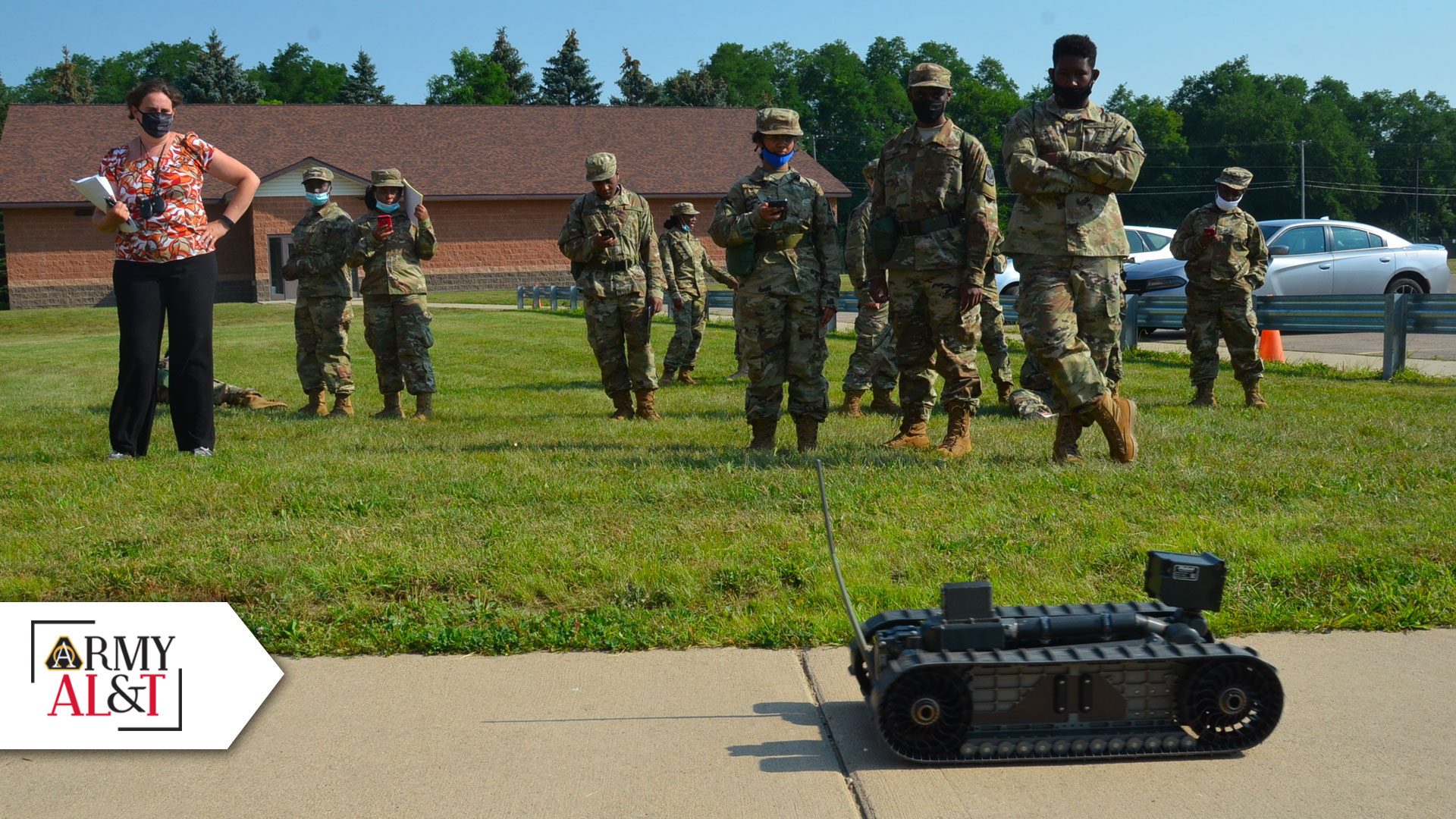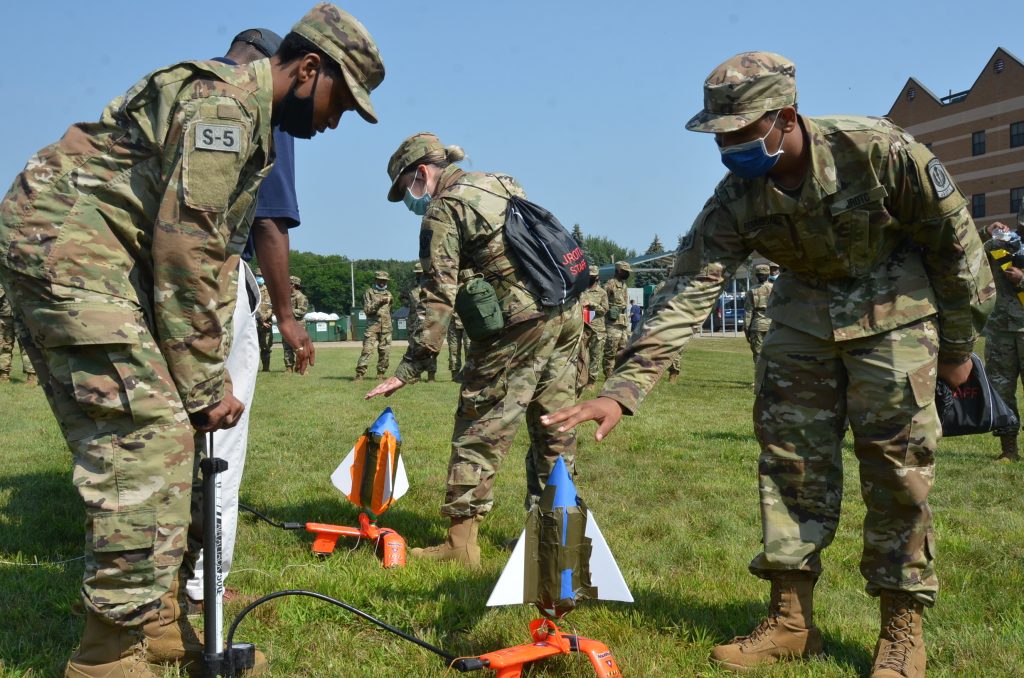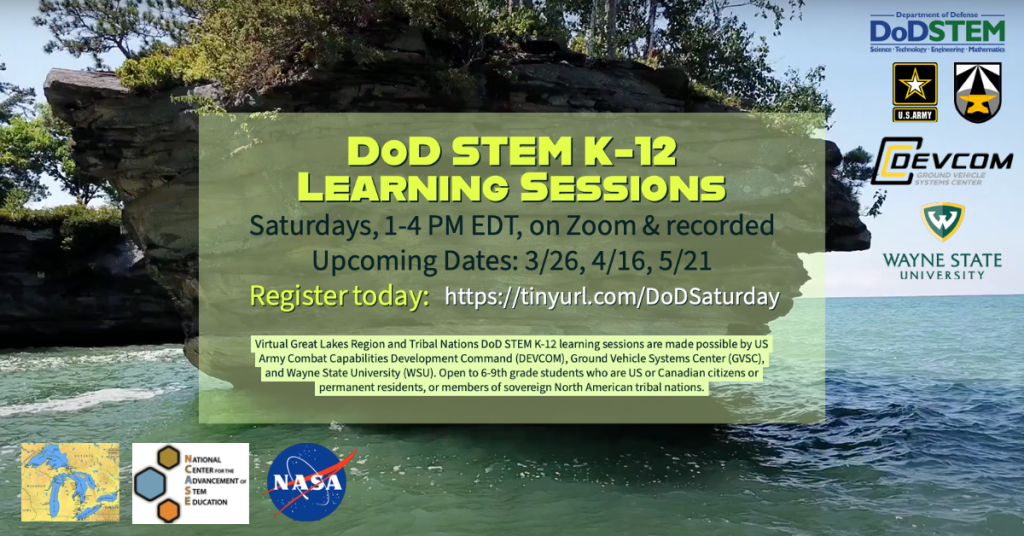
HANDS-ON EXPERIMENTATION: DOD STEM K-12 Cadets conduct “PackBot” velocity determination experiments at a STEM Day camp August 5, 2021 at Fort Custer, Michigan. (Photo by Jerome Aliotta, DEVCOM Ground Vehicle Systems Center)
Greg Chappelle has been running STEM programs with underserved populations before the rest of the world knew what STEM meant. He’s not giving up efforts to keep the Native STEM program afloat, even when funds run out.
by Cheryl Marino
When you don’t have enough of something, the way that DOD doesn’t ever have enough science, technology, engineering and math talent, it can pay to grow your own. That’s just what the Ground Vehicle Systems Center’s Greg Chappelle has been doing the last 28 years. He almost lost it all when funding ran dry, but he isn’t the kind of person that gives up easily.
Chappelle believes good talent is out there, it all just depends on where you look, what your resources are and how you go about your search. So, for nearly three decades, he has done whatever it takes to preserve a specialized program he founded called GLRTN DOD STEM K-12, the short version of the Great Lakes Region and Tribal Nations DOD Science, Technology, Engineering and Math K-12, which he has led and managed since 1994.
The goal of GLRTN STEM—an offshoot of the DOD STEM program—is to bring accessible, educational science, technology, engineering and mathematics (STEM) summer camps to children in Native and Indigenous communities in the Michigan area. Teaming up with Native American communities, Wayne State University and, more recently, Harvard University to expand outreach efforts, Chappelle hopes to create a talent pool equipped to serve the nation and evolve DOD’s competitive edge. Because of pandemic restrictions, the program has now gone virtual, but it never lost momentum. If anything, the shift to remote learning has brought surprising success with the opportunity for even greater outreach.

U.S. Army Ground Vehicle Systems Center DoD STEM Coordinator & HBCU/MI Liaison Officer Greg Chappelle, left, and DoD STEM K-12 mathematics teacher Nicole Ames-Powell, third from right, and DoD STEM K-12 physics teacher Grayling Mercer, far right, with JROTC cadets at a STEM Day camp Aug. 5 at Fort Custer, Mich.
KIDS DESERVE A CHANCE
“This program was needed. So I had that vision,” said Chappelle, who is both African American and Native American (of the Seminole Tribe, Florida). Chappelle can relate to the needs and circumstances of kids raised in impoverished and underserved communities. Despite growing up in the “hood of Detroit,” he took advantage of opportunities available to him and earned three bachelor’s degrees, two master’s, his teaching certificate and credits toward his doctorate—in the fields of chemistry, physics, electrical engineering, mathematics, history, sociology and English. But primarily, he said, he’s an educator who believes in sharing knowledge he’s acquired through personal experience.
“When I first started the program, I thought it might not be as important now, but it will be one day. In our society there are all kinds of diversity, ethnic and cultural issues, but we all have to work together at some point.” With heightened government focus on equity in the last two years, he said in a June interview with Army AL&T, the timing is right to increase outreach efforts and boost enrollment in DOD STEM. There are now 574 federally recognized Native tribes in the United States, and Chappelle is responsible for coordinating with 40 of them.
Much like the DOD STEM program mission to “inspire, cultivate, and develop exceptional STEM talent through a continuum of opportunities to enrich our current and future” workforce, Chappelle’s homegrown STEM program was designed in the form of a K-12 camp series and one Saturday a month.
It’s Chappelle’s contention that “kids of all cultures and ethnicities who have potential—from the most financially disadvantaged areas with the highest crime and special needs, as well as Native American and Indigenous kids—should all be given an equal chance to succeed.” But since Native American and Indigenous students are underrepresented in STEM, this STEM program is intended to combat disparities between the opportunities extended to the general population and those geared toward these underserved Native communities with unique educational challenges. It is also intended to attract those with talent to the future DOD workforce. According to Chappelle, “If this program is allowed to continue, we will be producing a great diversity of scientists and engineers for the defense of the nation.”
MUST-HAVE METRICS
For years the GLRTN STEM program operated with a small funding line furnished in part by the DEVCOM Ground Vehicle Systems Center HBCU/MI program. Once funding ended in 2010, Chappelle sought—and received—grants from the Office of the Secretary of Defense (OSD) to keep the program going, however, he knew he’d need to find a way to keep the momentum for the long term. “In order to get more funding for the program, the OSD needed some metrics to show data on how their investment was working,” he said. Although it was a reasonable request, showing hard statistics was no easy task. So he consulted with the National Science Foundation. The NSF suggested there would only be “longitudinal results” with this kind of study. In other words, he chuckled, “you won’t know the results until 20 years from now, when the kids grow up, graduate and go into their careers, which would be a long wait.”
But Chappelle has been with the DOD for 40 years. He knows the drill—so to speak. The only real way to measure the program’s success rate was to seek outside assistance in developing metrics. So he sought support from Harvard University, which “promotes university-wide engagement with Native American and Indigenous issues . . . through relevant research, teaching, partnership and exchange” through its Harvard University Native American Program (HUNAP). The overall goal of HUNAP is “to cultivate the development, achievement, and impact of American Indian, Alaska Native, Native Hawaiian, and other Indigenous students to further the goals of the Harvard Charter of 1650, which committed the president and fellows of Harvard College to ‘the education of the English and Indian youth of this country.”

TEN…NINE…EIGHT…: Cadets prepare to launch water rockets at a STEM Day camp August 5, 2021 at Fort Custer, Michigan. (Photo by Jerome Aliotta, DEVCOM Ground Vehicle Systems Center)
OBVIOUS BENEFITS
The Harvard assessment compared the grade point averages (GPAs) of the kids who attended the GLRTN STEM camp for eight or nine years against those who never attended at all to get an idea of the differentials. According to Chappelle there was “a pretty significant difference.” The kids who enrolled in the camp had a 3.43 GPA average, as opposed to a 2.94 GPA for the kids who didn’t. In addition to GPAs, he said “The kids that enrolled in the camp and were trained by us had direction and a clear career path, and the kids who didn’t enroll had little to no direction and were undecided in their major.”
The metric assessment showed obvious benefits, and Chappelle is hopeful that funding will continue for the program to flourish. He said to date he’s received funding every few years to keep the program afloat, but the struggle is ongoing. In 2010, the OSD issued a $400,000 grant to continue funding the GLRTN STEM program. Subsequent grants followed in 2013 for $300,000 and another in 2019 in the amount of $265,000.
“Basically, grants have totaled around $1 million in the last 12 years, but since 90 percent of the budget is administrative, we’re saving the OSD millions of dollars [going virtual] moving the program to Zoom,” he said. Not only has the shift to a virtual curriculum saved money, but it also has a greater outreach.

NATIVE COMMUNITY OUTREACH: As part of the Harvard, DOD GLRTN outreach project, a flyer for DOD STEM K-12 virtual learning sessions for 6-9th grade students was advertised to Native and Indigenous populations and posted on social media to get the word out to Native communities. (Image courtesy of Bridget Chemberlin, Harvard University)
A DECENT PROPOSAL
Since its inception, the GLRTN STEM program had mainly been conducted in-person through summer camps until the pandemic posed new challenges—and unexpected benefits. The switch from traditional, in-person courses to virtual instruction may have lost that personal touch but ended up with significant cost savings and a wider reach.
Chappelle said the biggest challenge with virtual learning is that you can’t build anything like you can in an in-person outdoor setting or a classroom. “But on the flipside, you can reach 800 more people for 90 percent less money,” in a virtual setting, he said. Adding as an example, a teacher who would have been paid thousands for in-person instruction could now be paid a lot less per hour for a Zoom class. According to Chappelle, “DOD STEM K-12 teachers with salary and TDY [temporary duty station] costs are paid about $2,500 per week [in-person instruction] versus $40.00 per hour for three hours of Zoom time and $35.00 [per hour] for three to four hours of Zoom teaching preparation time.” So for a virtual summer camp of two days versus a five day in-person on site summer camp teachers make $380.00 versus $2,500.00.
“When COVID diverted the Army and Tribal Nations to Zoom, we partnered with Wayne State University, and now the GLRTN STEM program has K-12 students nationwide virtually attending these educational Zoom sessions,” Chappelle said of the next-generation virtual camp initiative.
To move the program forward, assess its effectiveness and gain additional funding, Chappelle worked alongside Aaron Tadgerson, Bay Mills Indian Community and DOD Native liaison and Sandra Yarema, Ph.D., a professor at Wayne State University and the regional director of the Army Junior Science and Humanities Symposium (JSHS) to submit a case study proposal to Harvard University’s Native American Program Office and Education Department. The proposal was accepted and taken on by Harvard as the Bay Mills Indian Community (Ojibwa), DEVCOM GVSC, Wayne State University and Harvard University DOD STEM K-12 Tribal Nations Outreach Project.
A LITTLE HELP FROM HARVARD
In the spring of 2020 when the “pandemic disrupted everything,” said Eric Henson, a professor at the Harvard Kennedy School of Government in Cambridge, Massachusetts, Henson and his students eagerly accepted the proposal and took on the project to assist with DOD’s outreach assessment mission. Henson, a citizen of the Chickasaw Nation and a research fellow affiliate with The Harvard Project on American Indian Economic Development since 1998, teaches a course called Native Americans in the 21st Century: Nation Building II—a semester-long project that pairs graduate students with seven different tribal entities to participate in outreach and raise awareness about educational and career opportunities outside of their communities.
“We’re driven by the Native community, focus on what problems they have and ask, ‘How can we help?’” said Henson, who teaches virtual classes via Zoom to his graduate and undergraduate students, as well as Native K-12 students. “If you don’t expose kids to these things [math, physics and science], you end up with a vanishing number of people becoming scientists. If you could get a dozen people in junior high school interested, and then another half to enroll, and then another half to graduate, that’s a big accomplishment,” he said in an interview with Army AL&T.
Henson’s 10-year-old son adjusted well to remote learning. Henson added that, although the classroom setting has its benefits, the virtual experience can be even more engaging for kids than in-person instruction, when they can visualize more things at one time or in a shorter amount of time than if they were to physically get on a bus and experience one place at a time. The virtual option has afforded the opportunity for wider outreach, which is advantageous for the future of the program.
Since Henson and his students’ involvement, much of the program’s outreach has been done online and through social media, which he tepidly suggested is a “work in progress.” The social media outreach to K-12 students has been initiated but, he said, getting exposure and building a following will take some time. “Media presence isn’t easy. STEM camps just started to take this on, but it’s going to need some work as far as getting a lot of hits—and will need to be promoted right to get some interest. The Native communities themselves will need to cooperate in getting the word out to their communities, too,” Henson said.
Outreach aside, he said that the biggest challenge for the GLRTN STEM program is how to best capture a kid’s attention on a Saturday morning. “You have to be interactive and really keep them interested. Getting teachers that are interesting is also a huge challenge for keeping younger people focused and involved in a virtual setting.”
CONCLUSION
The DOD partnering of resources with other agencies and academia would ultimately drive college enrollment and add talent to the workforce. “Harvard has a great interest in attracting Native students and helping them succeed and foster brotherhood and sisterhood once they get here,” Henson said enthusiastically. “It’s interesting stuff, and I think it’s just great to be able to help Native students who didn’t think they’d ever be able to go to Harvard to get involved with math and physics,” he said of the university’s program and GLRTN STEM. “It’s important for them to know these opportunities are out there for them, and if you have the grades and your family makes under [$75,000] a year, there’s a place for you here, you can do it.”
Henson said that Harvard didn’t “move up to its charter,” or in other words, legislate in accordance with its defined rights and privileges (to further the goals of the Harvard Charter of 1650) until 1970 when the American Indian Program (AIP) was established at the Harvard Graduate School of Education to prepare American Indians for leadership in education. He said initially, AIP enrollment was 11 Native American students, which was the largest Native enrollment since the mid-1600s when the university opened. By 2021, Harvard had more than three dozen Native graduates.
“This is a great success for Harvard,” he said. And he can’t see any reason why the GLRTN STEM program wouldn’t see the same success in years to come, especially now with the virtual option. But it will take time to recognize how successful the program will be going forward—how many kids graduate, go on to colleges and universities of their choice and settle into their careers.
“How do you define success?” Henson speculated. “If you are making sure students have exposure to everything so that you get a diverse set of brilliant graduates entering the math and science fields, that’s success. The world cannot exist without highly skilled mathematicians, physicists and scientists. You have to find a way to expose all kids, especially Native kids, to all that there is to offer so they have a chance. You can do these camps from anywhere and you’ll have success.”
For more information contact gregory.a.chappelle.civ@army.mil at DEVCOM Ground Vehicle Systems Center or go to https://tinyurl.com/DoDSTEMCamps and www.go.wayne.edu/jsh-symposium. On Facebook, go to @GLRTNDODSTEMK12 and Twitter @glrtndodstemk12.
CHERYL MARINO provides contract support to the U.S. Army Acquisition Support Center at Fort Belvoir, Virginia, as a writer and editor for Network Runners, Inc. and Army AL&T magazine. She holds a B.A. in communications from Seton Hall University and has more than 20 years of writing and editing experience in both the government and commercial sectors. In addition to corporate communications, she is a feature writer and photojournalist for a biannual New Jersey travel magazine.







